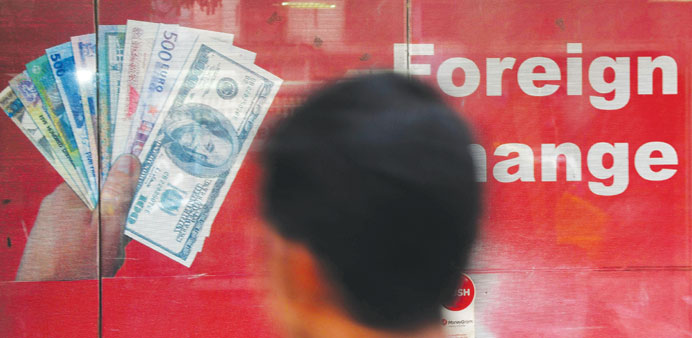A pedestrian walks past a foreign exchange dealer’s shop window with a poster of various currency notes in Mumbai on Friday. The rupee has lost 57% of its value against the US currency since it peaked at Rs39.40 to the dollar in February 2008.
AFP/New Delhi
Indian policymakers are looking increasingly panicky as they battle the worst currency crisis in more than two decades, and more worryingly there is no sign their remedies are working.
The rupee lurched to a new lifetime low of 62.03 to the dollar on Friday while the benchmark share index posted its biggest one-day fall since September 2011.
“None of the policymakers’ Band-Aid measures (from capital controls to tightening liquidity) seems to be working. They have not been able to turn the tide,” Rajeev Malik, economist at investment house CLSA, told AFP. “The government and the Reserve Bank of India are taking fire-fighting measures.”
The rupee has lost 57% of its value against the US currency since it peaked at Rs39.40 to the dollar in February 2008.
The currency’s strength began unravelling when Lehman Brothers collapsed later that year, triggering the global financial crisis.
But pressure on the rupee has mounted in the past two years as investor alarm over a slowing economy and a ballooning current account deficit—the widest measure of trade—has grown.
Part of the reason for the currency’s most recent slide—it has fallen 13% this year against the greenback—lies outside Indian policymakers’ remit.
The currencies of emerging markets globally have fallen on expectations that an increasingly buoyant US will soon roll back stimulus responsible for funnelling big investments overseas in quest of high yields.
But other reasons for the rupee’s drop are home-made—failure to move fast enough on economic reform, a series of government corruption scandals, perceptions of policy paralysis and the record current account deficit, analysts say.
Since June 1, overseas funds have pulled out $11.58bn from India’s stock and debt markets.
Investors worry that despite the long-term growth potential of the country of 1.2bn people, “things are not in shape in the interim period”, said investment house IDBI research head Sonam Udasi.
As the rupee’s woes have deepened, authorities have responded with a clutch of measures to try to stem its decline and avert a balance-of-payments crisis.
India has painful memories of its 1991 balance of payments crisis when it failed to attract enough foreign currency and was forced to fly 47 tonnes of gold as collateral for an International Monetary Fund loan in what was seen as a national humiliation.
Indian Prime Minister Manmohan Singh, who was finance minister at the time, was Saturday ruled out a repeat, saying: “There is no question of going back to the 1991 crisis.”
In the past few weeks, Indian policymakers have hiked short-term interest rates, announced plans to allow state firms to raise foreign funds abroad and curbed gold imports.
They have also threatened to impose higher duties on imported electronic appliances such as fridges, which are made locally.
But it is their most recent step—stealthily announced late Wednesday on the eve of a national holiday—that has fanned the deepest consternation.
The central bank sharply tightened controls on the amount of money firms and individuals can send abroad.
The move looked to observers like a disturbing throwback to the days before India unleashed its economic liberalisation drive in the early 1990s when Indians’ access to foreign exchange was strictly limited.
Confederation of Indian Industry president Kris Gopalakrishnan criticised the move as “retrograde”.
While the capital controls only apply to local individuals and firms, the restrictions may raise worries among overseas investors that they could be extended to foreign companies operating in India, analysts say.
Under the new policy, Indian individuals can send just $75,000 out of the country annually, down from $200,000 - making it tougher to pay children’s overseas university fees, for example.
Companies can invest abroad only 100% of their net worth, down from 400%—though the central bank says firms can ship out more money if they give authorities a good reason for doing so.
“While the authorities aim to reduce foreign-exchange volatility, we fear they may end up sending a panic signal,” Nomura economist Sonal Varma said.
There have been no signs so far of domestic capital flight but analysts say the controls may have been tightened to avert one in the face of India’s troubles.
The economy expanded last year at a decade-low of 5% and indicators this year have been grim with economists warning about “stagflation”—a combination of high inflation and low growth.
With an election to be held by May 2014 and pro-market reforms divisive, there is no way the Congress government can undertake root-and-branch reforms needed to put the economy back on track, economists say.
“There is a complete lack of faith in the markets” about India’s outlook, said Param Sarma, chief executive at consultancy firm NSP Forex. “We are slowly, but surely, likely to enter a phase of a crisis,” he said.



